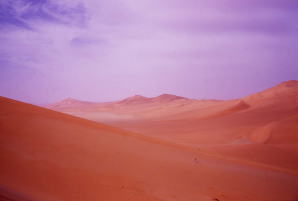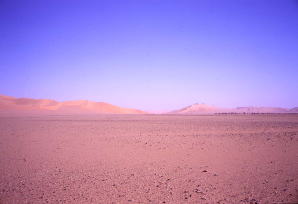



It is difficult to number the population of the Sahara desert, because the limit
of each territory isn't well-defined and also basic rule of the population statistics is
not same by countries and the international organization.
The estimated population is as follows.
In Mauritania, the maure ( arabinized Berbers ) consists 500,000 nomads and 100,000
permanent residents.
The moroccan Sahara has 15,000 permanent residents of Berber and 30,000 nomads.
The southern Algelia has 62,000 habitants, the two third of them are permanent residents.
Globally, the nomads are Arabic in the northern part and Berber in the southern part . The later, the Touareg, leads a
nomadic life in the northern part of Mali, Niger and Chad.
The Fezzan region in Libya has 30,000 permanent residents including 10,000 half-nomads.
The Berber in the south Tunisia settled down. The tribe of Toubous in Tibesti, Borkou and Wnnedi, ( not Berber not
Semite ) has 35,000 nomads.
The saharan permanent residents in Sudan and Egypt are 15,000 and 30,000.
The nomadic life is simple but their lives are threatened by some governments that the administratie policy neglect
the characteristic of nomadic culture. The old days, plundering was the most important activity for them, but now they
settled down to raising cattle.
Among predeceddors were the notorious Tuareg, otherwise known as the
" blue men of the veil". When indigo-blue robes appeared on the camel back at the
crest of a sand dune, saharan tavellers knew they were doomed to decimation
by the desert's most romanticized nomads.
Originally from Africa's Mediterrannean coast and related to the warlilke Berbers,
the Tuareg migrated southward into the desert after camels were intoduced to the
North Africa region early in the first century A.D. There for generation after generation they controlled most of the
central Sahara's north - south trade routes as both brigands and caravanners themselvs. In ancient times they battled
both Egyptian and Roman armies. Around beginning of 20th century, they battled French colonies for cotrol of their
desert empire. In one of their final and largest enconters, in 1916, the Tuareg were subdued by the rapid-fire rifles of
a French force near Oursi in present day Burkina-faso. Since then the Tuareg have lived primarily as trader
pastoralists, moving their camels, goats and sheep from place to place throughour the year, transporting their tents,
furnitures and other belongings on the backs of donkeys. The " blue men " were named for the fact that the indigo
dye in their voluminous robes rubs off on their light-complected, perspiring skin. Winter and summer, regardless of the
Sahara temperature, they cloak themselves in their flowing garb and turbans. Many centuries they learned that the
robes protect their skin from the sun's burning rays, slow evaporation and minimize water loss by creating a layer of
cool air around the body.
Despite Muslem tradition - which dirests women of the faith to keep their faces and bodies under wrapes - Tuareg
men are the ones who wear the veils in their society. Women, faces bared and at liberty to be assertive in public, are
highly respected members of the Tuareg culture and like men can be property holders.
In addition to having a historic role as marauders, the Tuareg have long been important traders of salt, one of the
desert's most precious resources. Salt is abundant in the Sahara; some mines are still worked, and scores of others
have long been covered over by shifting sands. For centuries, Tuareg salt caravans have travelled during the winter to
the salt pits at Bilma in present day Niger.
One Tuareg caravan in the mid-1960's, for example, included 10people and about 100 camels. At Bilma, the Tuareg
traders bartered for salt cones at the equivalent of U.S.15cents apiece, wrapped them in straw matting, and then
hoisted about six of the 18 kg packages onto the back of each camels. The Tuareg party them trekked southwest ward
for more than a month, across hundreds of miles of blazing sand in a desert region known as the Tenere. Finally, at
Agades, an oasis in central Niger, the Tuareg turned directly south toward markets, like Maradi, in Niger, and perhaps
Kano in Nigeria. There the Tuareg traded the salt cones at a profitable rate equivalent to U.S.$1.50 per cones for tea,
millet and sugar, all of which appear in their diet and for the cotton used in their celebrated blue robes. Once the
business was transacted , the trade route cycle began again as the blue men retracted their steps back to Bilma.
![]()
Their life style and costume ( veiled men ) are similar to the black Tuareg,
the Tuareg is berberphone but the Toubou belongs to a group of malo-chadan.
The population is estmated at 100,000. They live in a center of the south
Sahara, particularly in Tibesti, Ennedi, Fezzan ( Libya and Algelia ). Now cattle
breeding is the main activity for the Toubou as like the Tuareg. In the north,
the Toubou raises camels and goats, in the south, they breed of cattle.
But the old days, plundering is the most important acritity for them.
The hierarchic society has been down in the Toubous. Some clans constitute the aristocracy by the head of the tribe ( derde ) and
contrlled vassals, serfs, slaves and artisans.
![]()
In the west, (Mauritania, Senegal and Soudan ), the Moor possesses the hierarchic and also decentralized society.
The population of the Moor is 450,000. The warriors and marabouts dominate their society. Marabouts are prestigious
islamic and particularly, in the XVIII they have been influential. Their languages " hassanya " is a dialect of
arabo-berber. A kind of their ceremonies is " atey ( tea )", in which they put confidence among different tribes.
When they meet and chat, they have this ceremony of tea, even during armistice. The Moor, who breeds camels, leads
a nomadic life in the north.